You know what’s harder than gaining customers? Retaining customers.
If you’re confused as to why we are discussing customer retention instead of customer feedback management, think of it this way:
96% of customers are likely to ditch a company after one bad customer experience. That means there’s a very thin margin for businesses to make mistakes.
That’s where collecting feedback comes in to save the day. Asking customers directly about their experience saves you so much time speculating and guesstimating.
But with feedback pouring in from multiple channels, how do businesses handle customer feedback management?
Let’s discuss that and more about the customer feedback management process. By the end of this article, you’ll be able to devise your own customer feedback strategy and manage insights from multiple sources effectively. Then, you can channel those insights into your development, marketing, and optimization strategies.
What Is Customer Feedback Management?
As the name suggests, CFM is streamlining and compiling customer feedback from different sources and channels to improve customer service and experience.
With the right customer feedback management process, you’ll be able to break the data chunks into actionable insights.
The question is — what are the channels to collect the feedback?
Here they are:
- Online surveys
- Live chat software
- Third-party reviews
- Comments and reviews on social media
- Data from customer-facing teams
- Heat Mapping tools like eye tracking, mouse tracking, etc.
- Focus groups
- Customer interviews
- Session recordings
Types of Customer Feedback to Collect
Customer insights come in many shapes and forms; what matters is how you analyze customer feedback, streamline it, and work on it. You can find rich customer insights in the following:
1. Opinions
Customer opinions are the feedback you get from product reviews on social media and websites. Opinions express what customers think about your brand, products, and services. Opinions can be formed based on experience, influence from other customers, and online reviews.
2. Feature Request
One of the most crucial types of customer feedback is the request to remove or add new features and functionalities.
Your product development team may know a lot about the product and target customers, and yet, customers are the ones who can truly tell what can make your product/service useful. So, prioritize these requests based on factors like required resources, relevancy, and more.
3. Usability Issues
If customers have difficulty using your product, you’ll hear about it through your customer-facing teams. These are great insights as you can improve the problem areas and offer a trouble-free product experience.
4. Suggestions
Customers often leave their feedback in the form of suggestions on social media, feedback widgets on your website, or the comment section in your blogs. Of course, only some suggestions are worth considering, so make sure to go through them all and consider the most relevant.
Customer Feedback Management: Why Is It Necessary for Business?
If you’re asking yourself, “why is having a customer feedback management system such a big deal,” we’re here with some answers:
1. Feedback Helps Reduce Churn
Think of it this way: Why would you, as a customer, abandon a business?
Simple: If you have a bad experience with it. It could be anything from a lacking website user experience to unpleasant customer support interactions.
But if the same company puts effort into understanding your customer pain points, you’ll consider sticking, wouldn’t you?
Similarly, if you properly collect & manage customer feedback to procure actionable insights, then rectifying your errors and providing a worthwhile experience would come naturally.
Why don’t we understand this with an example:
CASE STUDY: BELRON
Belron is a windshield offering brand operating in the US and UK. Even though their customers are the ones in need of repairing their windshields which requires them to make immediate purchases , the company faced a high bounce rate on the website.
Baffled, the team at Belron turned to feedback collection using the customer feedback management solution Qualaroo. With the exit-intent surveys, it captured the feedback from the churning customers to understand the reasons behind it.
The team learned that they had multiple customer journeys they had never considered. Resultantly, Belron improved its product strategy with new customer journeys and reduced website churn.
2. Boosts Revenue Generation
Everything is related when it comes to business. So, if you reduce customer churn, chances are you’ll see a spike in your revenue generation.
Why?
Because it’s more cost-effective to retain existing customers than to acquire new ones. Plus, with customer retention, you can ensure a steady supply of repeat business.
CASE STUDY: KINGSPOINT
KingsPoint is a conversion-improving service provider helping its clients solve their unique conversion problems. For this task, the agency uses Qualaroo surveys to collect contextual customer feedback to understand the reasons for low conversion rates.
With the collected feedback, KingsPoint not only boosted its clients’ conversion rates but also saved approximately $60,000 a year by solving the challenges. And any expense saved is the revenue earned.
Also read: Feedback: Your Hidden Power To Proactively Kill SaaS Churn
3. Stronger Customer Relationships
If customers see you working hard on improving their experience and resolving their pain points, it’ll only impart a positive image of your company. It builds their trust in your brand, forging a strong relationship.
According to Microsoft’s report on the state of customer service, a majority of customers say that “they have a more favorable view of a brand or organization that offers a mobile responsive support portal”
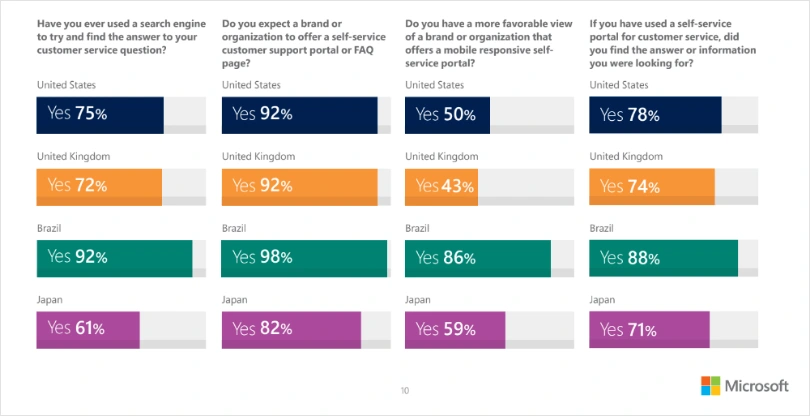
4. Data About Key Customer Groups
Customer feedback doesn’t just let you in on customer experience and satisfaction; it’s a rich source to get to know your customers more deeply. With the right survey questions and data analysis, you can find details about their preferences, background, shopping habits, and much more.
CASE STUDY: LALAMOVE
Lalamove is an intra-city logistics company operating in Asia. It uses surveys to collect customer data from the regions they want to target next.
The survey feedback helps them understand their demographics, needs, wants, and challenges. The company also uses customer sentiment data to keep a check on its customers and their experience.
Bonus read: 60+ Popup Survey Questions to Ask Your Visitors & Customers
Customer Feedback Management Metrics to Track
Metrics for customer feedback are benchmarks companies use to evaluate their performance and the impact of their efforts. So, when you think of customer feedback management, also consider tracking these customer satisfaction metrics:
Customer Satisfaction Score (CSAT Score): This tells you how satisfied your customers are with your product/services and overall experience.
Customer Effort Score (CES): CES metric helps you understand how easy or difficult your product is to use.
Net promoter Score (NPS): This metric tracks how many promoters and detractors you have in terms of customer loyalty.
Customer Service Satisfaction (CSS): This metric focuses on customer satisfaction related to customer support service.
Customer Health Score (CHS): It’s more of a process to analyze customer behavior and predict if customers are likely to stay.
Customer Churn Rate (CCR): it examines the rate at which customers churn away.
Abandonment Rate: It calculates the percentage of customers leaving the checkout process halfway without buying.
First Response Time (FRT): It measures the time taken by an organization to reply to customers reaching out via different channels.
First Contact Resolution (FCR): It aims to track the percentage of support calls resolved in the first interaction.
Value Enhancement Score (VES): Focuses on gauging users’ views and perceptions of products and services.
You can refer to our detailed blog “Customer Satisfaction Metrics To Monitor” to learn about each of these metrics.
FREE. All Features. FOREVER!
Try our Forever FREE account with all premium features!
Four-Step Customer Feedback Management Process To Follow
Managing customer feedback the right way unlocks so many valuable insights. So, if you wish to set up a customer feedback management system for your business, you must follow these four steps.
Step 1: Collect The Feedback
Before you even start collecting customer feedback, you must decide how to ask for it. You can leverage multiple survey channels at once.
For instance, you can conduct on-site and in-app surveys with insights from third-party review sites or customer interviews.
So, if you go with online surveys, you should know the right questions to ask at the right time. With the right customer feedback management platform, this won’t be a problem.
Here are some suggestions on what questions you can ask to procure particular types of feedback:
Question for NPS survey:
“On a scale of 0-10, how likely are you to recommend our product/service to others?”
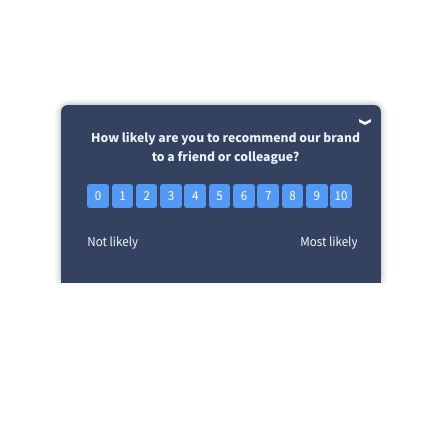
Question for CSAT survey:
“How satisfied are you with the feature/product/service?”
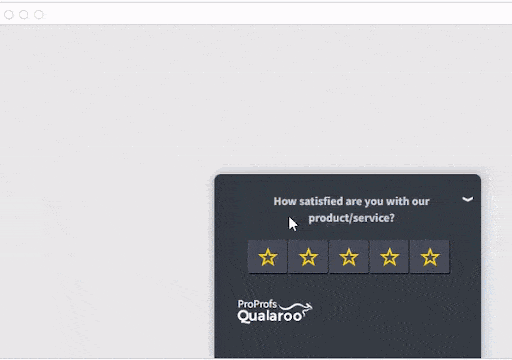
Question for CES survey:
“Overall, how easy was it for you to solve your problem with [Product/Service]?”
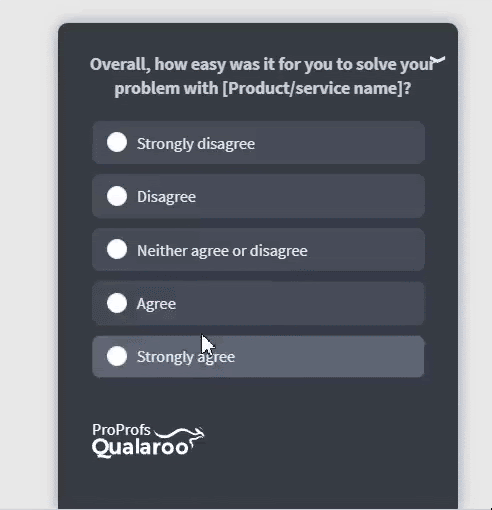
Question for Exit-intent survey:
“If you don’t plan to make a purchase today, can you tell us why not?”
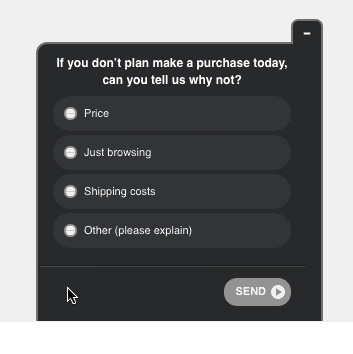
View This Exit-intent Survey Template
And what about filtering the non-relevant respondents? Well, you can add screening questions to your surveys.
Step 2: Filter out Constructive Criticism and Requests
It’s a given that not all feedback you collect amounts to something. You must learn to tune out the irrelevant and unconstructive feedback to focus on the one that matters.
It’s about filtering out the gunk from the gold, and a good CFM tool with advanced analytics can facilitate the process.
You can also use technology such as Sentiment Analysis that lets you filter data based on customer sentiment represented in the written feedback.
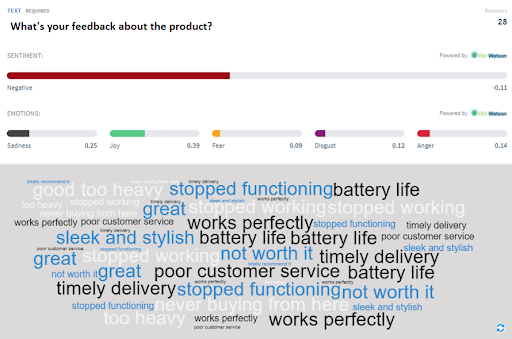
Bonus read: 15 Best Sentiment Analysis Tools to Choose
Step 3: Prioritize the Actionable Insights
Once you have useful and rich feedback insights, it’s time to prioritize. Of course, each piece of feedback is crucial for you, but you can only take care of some at a time.
To start somewhere, you can focus on low-effort feedback and at-risk customers. For example, it’s time and cost-effective to resolve the lack of information on product pages, but it takes strategic resource utilization to fix a problem related to the checkout process.
Similarly, you can wait for feedback from a customer rated 9 on the NPS, but you must prioritize feedback from a detractor who gave low ratings since they are at risk of churn.
Step 4: Make Your Customers Feel Heard
Since your business relies heavily on the voice of customers, they need to feel heard too. After you’ve acted on their feedback, you should communicate the same to them.
Let them know you addressed their concerns and that their feedback matters. For this, you can send follow-up emails and surveys to let them know and also collect insights on their customer experience after the issue resolution.
5 Best Practices for Customer Feedback Management
It’s easy to make mistakes or skip a few things when dealing with such vast amounts of data. And while your heart might be in the right place as you’re establishing a customer feedback management system, you may lose the way.
So, you can take help from these best practices and flawlessly implement a robust customer feedback management process.
1. Have Clear Objectives
One of the common mistakes businesses often make while collecting feedback is collecting it for the sake of it, with no clear goal.
Your feedback objectives can be as specific as gauging customer feedback on the pricing for a particular product or as general as collecting overall customer satisfaction.
But it’s necessary to have a clear vision of why you want to collect the feedback and what kind you require to achieve what goal.
That’s how you’ll decide what channels are suitable and tailor the customer feedback management process to your objectives.
For example, if you want to explore customer pain points throughout the customer journey in detail, customer interviews are the ideal way to go about it.
But if you want to explore the online customer experience, then you can go for online surveys, live chat feedback, online reviews, etc.
2. Establish a Multi-Channel Feedback Loop
As we discussed above, you don’t have to choose one or the other for managing customer feedback. A balanced combination of multiple feedback channels will give you diverse feedback and rich insights into customer trends, sentiments, opinions, and behavior.
For example, you can leverage social media to track new customer trends using polls, online review sites to gauge customer sentiment and opinion about your brand, on-site surveys to gauge customer loyalty & contextual experience, and so on.
Just remember one thing:
Merely collecting feedback isn’t the goal. Whatever channel you employ, make sure to have relevant tools to analyze the data and extract useful insights.
3. Sort the Collected Feedback Into Categories
When you have a huge pile of feedback data, it can become overwhelming quickly. In that case, it helps to sort the data into categories to gain some clarity and plan out your next moves.
For example, sorting the qualitative vs. quantitative feedback data will make it easier for you to analyze.
Doing so helps you streamline the process, and you can assign each feedback category to the respective team to take prompt action. More so, organizing the data helps you explore patterns in the feedback data.
4. Use Feedback for Internal Brainstorming
Guesstimates and working on your hunch don’t work. If you want your business strategies to bear fruit, you need reliable data to fall back on.
With rich insights, it becomes easier to brainstorm with the teams about the best course of action and the possible solutions you can offer to customer issues.
5. Act on the Feedback
Once you have all the valuable insights, thanks to your customer feedback management effort, you need to act on the feedback. If you don’t, all you’ve done so far will be for nothing, and the churn will prevail, depleting your revenue and growth.
It’s where prioritizing the feedback you did after analysis will help you roll out updates in a streamlined way.
3 Real-Life Examples of Effective Customer Feedback Management
Managing customer feedback can seem daunting if you don’t know how to go about it. So, here are a few real-life customer feedback management examples of brands and how they leverage rich customer feedback.
1. Udemy
You must have heard about Udemy and how this edutech platform helps millions learn online through paid and free courses. To facilitate learning, Udemy introduced an auto-captioning feature.
It didn’t just introduce this feature but also conducted in-app and on-site surveys using Qualaroo to understand how this feature performs for users and what needs improvement.
Here’s what Claire Menke, Director of UX Research for Udemy, had to say —

The survey feedback data helped Udemy improve the auto-caption feature and give the smoothest learning experience.
2. Salesforce
Salesforce is a cloud-based software that provides organizations with tools to manage sales, marketing, and customer relations on a global scale. One of the key products offered by Salesforce is the Salesforce Service Cloud, which enables businesses to provide excellent customer service through a range of communication channels. Additionally, Salesforce introduced the IdeaExchange portal within the Service Cloud platform to encourage users to share feature suggestions that can improve the overall functionality of the platform.
On the platform, customers can add their suggestions and also vote for other customers’ feature suggestions. Once the ideas reach 250 votes or 2500 points each, the product development team reviews the requests and manages them accordingly.
Doing so helps the platform offer what the users want and stay relevant in this cut-throat competitive market.
3. Airbnb
Airbnb is an online marketplace for lodging and rentals that offers multiple channels for customers to share their feedback.
The company conducts brief surveys after customers have completed their stay. This way, Airbnb can collect feedback without seeming pushy.
For Airbnb, online surveys work better than offline cards since they bring more responses. Why? Because customers can respond to the surveys in their own time.
The quick feedback helps Airbnb to manage each property and update its ratings and information on the platform accordingly.
*Check out our blog on “How Top 15 Brands Use Customer Feedback Effectively” to see more examples of how companies of all sizes use feedback.
Leverage Customer Feedback Management to Boost Your Business
Customer feedback management is a great way to listen to the voice of customers in a streamlined way. The process helps companies organize and manage the data, so it’s easy to analyze.
A big part of making this process successful is having a customer feedback management solution that collects in-content feedback and derives qualitative and quantitative data.
But as mentioned in the best practices above, everything will amount to nothing if you don’t act on the feedback. So, strategize the feedback execution with your team to improve your brand experience and customer retention. And when you nail the execution, you’ll see positive results.
 Tips
Tips
We’d love to hear your tips & suggestions on this article!
FREE. All Features. FOREVER!
Try our Forever FREE account with all premium features!

 We'd love your feedback!
We'd love your feedback! Thanks for your feedback!
Thanks for your feedback!




